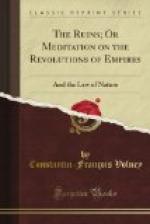* There are absolutely no other monuments of the existence of Jesus Christ as a human being, than a passage in Josephus (Antiq. Jud. lib. 18, c.3,) a single phrase in Tacitus (Annal. lib. 15, c. 44), and the Gospels. But the passage in Josephus is unanimously acknowledged to be apocryphal, and to have been interpolated towards the close of the third century, (See Trad. de joseph, par M. Gillet); and that of Tacitus in so vague and so evidently taken from the deposition of the Christians before the tribunals, that it may be ranked in the class of evangelical records. It remains to enquire of what authority are these records. “All the world knows,” says Faustus, who, though a Manichean, was one of the most learned men of the third century, “All the world knows that the gospels were neither written by Jesus Christ, nor his apostles, but by certain unknown persons, who rightly judging that they should not obtain belief respecting things which they had not seen, placed at the head of their recitals the names of contemporary apostles.” See Beausob. vol. i. and Hist. des Apologistes de la Relig. Chret. par Burigni, a sagacious writer, who has demonstrated the absolute uncertainty of those foundations of the Christian religion; so that the existence of Jesus is no better proved than that of Osiris and Hercules, or that of Fot or Beddou, with whom, says M. de Guignes, the Chinese continually confound him, for they never call Jesus by any other name than Fot. Hist. de Huns.
** That is to say, from the pious romances formed out of the sacred legends of the mysteries of Mithra, Ceres, Isis, etc., from whence are equally derived the books of the Hindoos and the Bonzes. Our missionaries have long remarked a striking resemblance between those books and the gospels. M. Wilkins expressly mentions it in a note in the Bhagvat Geeta. All agree that Krisna, Fot, and Jesus have the same characteristic features: but religious prejudice has stood in the way of drawing from this circumstance the proper and natural inference. To time and reason must it be left to display the truth.
At these words, the Christians set up a general cry, and a new dispute was about to begin; when a number of Chinese Chamans, and Talapoins of Siam, came forward and said that they would settle the whole controversy. And one of them speaking for the whole exclaimed: “It is time to put an end to these frivolous contests by drawing aside the veil from the interior doctrine that Fot himself revealed to his disciples on his death bed.*
* The Budsoists have two doctrines, the one public and ostensible, the other interior and secret, precisely like the Egyptian priests. It may be asked, why this distinction? It is, that as the public doctrine recommends offerings, expiations, endowments, etc., the priests find their profit in preaching it to the people; whereas the other, teaching the vanity of worldly




